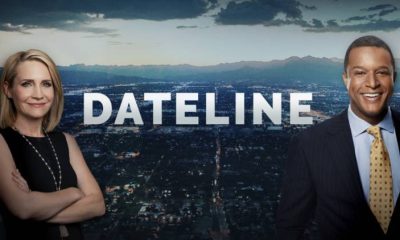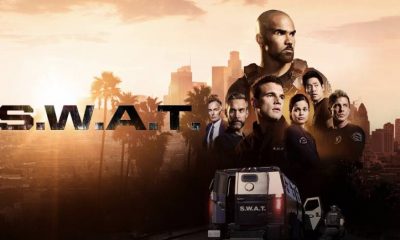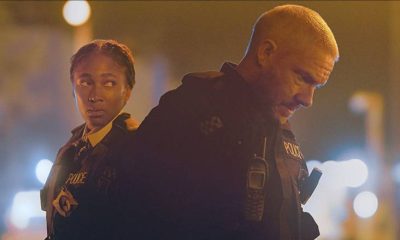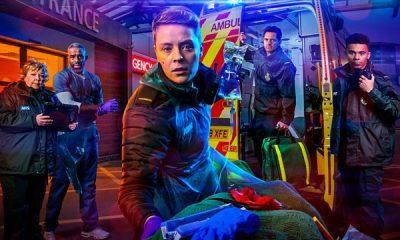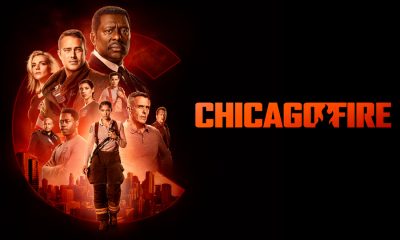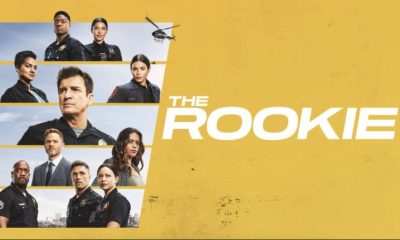Features
A Millenium Through The Movies or a thousand years of history as seen by Hollywood
Join us for an epic journey through the twentieth century with history as seen through the eyes of Hollywood, with a glimpse into pre-history and a look at where we are headed…
A Short History of the Human Race Prior to 1900
Our journey back in time begins with a brief survey of the millennia preceding the 20th century. Now, bear in mind that we’re covering a lot of ground here. Naturally, we’ve decided to stick to the biggies: Moses, King Arthur, and so forth. OK, sure, a lot of this isn’t historical, in strict point of fact. On the other hand, the stories we tell ourselves, about ourselves, are as much a part of who we are as The Way Things Really Happened, right? Go with us on this one.
The Prehistoric Era: Quest for Fire, 1982
Director Jean-Jacques Annaud’s poignant mini-epic is set among Ice Age people, who speak in an authentic primitive dialect worked out by that linguist, wit, and Clockwork Orange author, Anthony Burgess.
The Dawn of Civilization: The Ten Commandments, 1956
The human race moves to the big city, begins to kick each other around, and finds God.
The Roman Empire: Spartacus, 1960
The wittiest and most passionate of the many Roman Empire movies on tap, thanks to the big-hearted lead performance by Kirk Douglas, Dalton Trumbo’s sharp dialogue, and Stanley Kubrick’s hawk-eyed direction.
Anno Domini: Jesus of Nazareth, 1977
Of the many filmed variations on the Christ story, Franco Zeffirelli’s excellent six-hour epic (written by the ubiquitous Anthony Burgess) is the finest in English, equally moving to believers and non-believers alike.
Excalibur
The Dark Ages: Excalibur, 1981
John Boorman’s adaptation of Malory’s Le Morte d’Arthur neatly bridges the gap between the fall of Rome and the rise of Christianity; as Merlin shrugs at one point, “The one God comes to drive out the many gods.”
The Age of Enlightenment: Romeo and Juliet, 1968
Filmed in the well-preserved medieval streets of the Italian countryside, Franco Zeffirelli’s adaptation of Shakespeare’s most famous play is a sumptuous snapshot of the dawn of the Renaissance.
The Elizabethan Era: Shakespeare in Love, 1998
This exuberant postulation of the young Bard as struggling playwright wittily distills a period in history when language and love seemed to be reborn as twins.
The Birth of a Nation: The Last of the Mohicans, 1992
Daniel Day-Lewis throws tomahawks, fires muskets, and leaps waterfalls; the evocation of primordial America and its lost peoples is accomplished unforgettably here.
The Industrial Revolution: Barry Lyndon, 1975
Evokes the same era as Mohicans with a longer reach, setting the stage for the immense leaps in technology and overall enlightenment (or so we like to call it) that would follow.
The Way West: My Darling Clementine, 1946
John Ford and Henry Fonda produce arguably the most soulful portrait of the American push west, accomplishing miracles of tenderness and insight in a brief space.
A House Divided: Young Mr. Lincoln, 1939
A vibrant portrait of Abraham Lincoln (the closest spiritual titan we’ve got, at this end of human history, to a Moses, a Jesus, or a Shakespeare) and also a fairly global look at the United States when it was young.
The Civil War and Reconstruction: Gone With the Wind, 1939
The most commercially lucrative movie ever made is the perfect Young follow-up, because it so memorably captures the war-torn era over which the grown Mr. Lincoln presided.
Heading Toward the Space Age: Around the World in 80 Days, 1956
Ends the 19th century in a triumphal grand tour that circles the globe: bullfights, Balinese temples, California gold rushes, and Indian attacks are all spanned in its Herculean sweep — an ideal point at which to bid the distant past goodbye.
1901 to 1920
Looking over the films that characterize the dawn of the 20th century, it’s fascinating how frequently the word “loss” comes to mind. That seems to be a theme that reaches forward across the decades.
Departing the Age of Innocence: The Magnificent Ambersons, 1942
“The magnificence of the Ambersons began in 1873,” Orson Welles tells us at the beginning of his early masterpiece, but most of this grand, intimate epic is set after the turn of the 20th century. We watch as the horse-and-buggy splendor of the 1890s is traded — with a rapidity that catches the well-to-do Ambersons off guard — by the intrusion of a newfangled contraption called the automobile.
The Melting Pot: Ragtime, 1981
E.L. Doctorow’s bestselling novel, set in the glittering New York of 1904, was translated into a magical film by Czech maestro Milos Forman, who presents turn-of-the-century America as the crest of a wave of immigration. All classes are on display here, from the wealthiest and most spoiled — an architect is shot at a rooftop gala by a deranged young millionaire — to the poorest and most oppressed.
Decade of Decadence: Titanic, 1997
Confronted with an era of wildly divergent wealth and poverty, James Cameron decided to put the whole society on a big luxury liner and sink it. This budget-busting blockbuster became a huge success not only because it plants Kate Winslet so memorably in the arms of Leonardo DiCaprio, but because in recapturing the grandeur of our lost early century, it speaks so deeply to our own jitters about the dawn of the new millenium.
The Wild Bunch
Requiem for the Gunslinger: The Wild Bunch, 1969
It may seem to defy chronological order to introduce Sam Peckinpah’s elegiac masterpiece after Titanic, but guess again: the Mexican adventures of this romantically doomed, strangely immortal gang ars set in the time of Pancho Villa, 1915. Peckinpah closes the Old West in style and at the perfect historic moment, too. These outlaws have absolutely outlived their own times — a Stutz Bearcat booms through the movie midway, like a gunshot at a concert — and they know it.
Seeds of the American Dream: Days of Heaven, 1978
A few hundred miles to the north, but a light year away in terms of dreamy emotion, Terrence Malick unfolds a tragic romantic triangle in the rolling wheat fields of the Texas panhandle during the waning of President Woodrow Wilson’s first term in office. The beauty of the movie’s viewpoint belongs to Malick’s eye and young Linda Manz, its narrator. A bright biplane soars through the empty sky; a flying circus lands, and shows Charlie Chaplin movies — a magical evocation of the sense of wonder with which young Americans beheld their future.
World at War: Paths of Glory, 1957
The spiritual density of the catastrophe that was World War I has never been better measured on film than in Stanley Kubrick’s account of an impossible attack on a worthless hill. When obedient infantrymen fail to take it, three soldiers are sentenced to death at random. Kubrick’s great camera eye — which casts these men, against the black and white tiles of the lavish courtroom where they are tried, as tragic chess pieces — never loses sight of the coldness of fate, or the repeated insults to honor and decency that all war calls forth.
The Desert Fox: Lawrence of Arabia, 1962
“The trick,” T.E. Lawrence tells us, “is not minding that it hurts.” David Lean’s masterpiece presents what the British military called “a sideshow of a sideshow” of the First World War. The English and Germans fight for control of the Arabian desert until Lawrence, an eccentric, instinctive leader stands the conflict on its head by taking the side of the forgotten Arabs.
Red October: Dr. Zhivago, 1965
Also courtesy of Lean, we get that other sideshow to the First World War: the Russian Revolution. An era ends much as happened aboard the Titanic, only here it’s not a boat that sinks, but the hope of democracy. The tragedy is balanced by an unforgettable image of true love — wonderfully enacted by Julie Christie and Omar Sharif, to the accompaniment of Maurice Jarre’s bittersweet score — the only sane antidote to any historic upheaval.
Russian Redux: Reds, 1981
Warren Beatty tells a very different love story, and throws a distinctly American light on the same events. What sets this stirring saga on its feet is not only its epic sweep — which spans the years from 1911 to 1920 — but its use of “witnesses,” actual players and participants in the passions of that era who bring the full flavor of lived-in reality to the richly detailed portrait.
Prelude to Prohibition: Legends of the Fall, 1994
Edward Zwick’s movie translates the biblical sweep of Jim Harrison’s novel with beauty and a ripe sense of loss, ushering us through the final years of World War I and on into the Roaring Twenties. Anthony Hopkins is particularly superb here — this film contains some of his finest work ever — and of course Brad Pitt, sporting a grin that could warm a woman’s heart or a snow-dusted prairie, ain’t too shabby either.
1921 to 1930
In becoming the dominant global power following World War I, America stepped boldly to the forefront of the world stage. This Great Leap Forward was not without its growing pains: witness Prohibition. The carefree spirit of the times couldn’t be wholly repressed by government meddling, however, and was exuberantly made manifest in jazz, flappers, gangsters, and the birth of Hollywood.
Tramps and Scamps: The Kid, 1921
The quintessential ’20s movie captures the era with an immediacy and depth of feeling not quite available to later period pieces. Charlie Chaplin was already a beloved figure around the world by the time he made this film, so he was free to experiment. The result mingles emotion and the potential for tragedy with the Little Tramp’s familiar slapstick, and was the longest Chaplin film ever produced at the time of its release. The movie offers a Dickensian view of ’20s life — the Model T cars, the swaybacked rooftops in the poorer neighborhoods, and the ingrained, unthinking cruelty with which the haves of that world treated the have-nots.
Portrait of the Artist: Chaplin, 1992
By way of understanding Chaplin himself, and the era from which he sprang, a perfect follow-up is Richard Attenborough’s 1993 biopic Chaplin, in which Robert Downey Jr. virtually reincarnates the towering slapstickian. The star gets a healthy assist from Kevin Kline, who plays the Little Tramp’s pal, matinee idol Douglas Fairbanks. The great Sven Nykvist photographed the picture; its images have a perfect ’20s glow, and fully capture the excitement of the birth of movies.
Guys and Dolls: Some Like It Hot, 1959
Billy Wilder’s comedic masterpiece begins with a legendary gangland shootout — the St. Valentine’s Day massacre — and follows the two luckless jazz musicians who witnessed the killings (Tony Curtis and Jack Lemmon) as they flee into hiding, disguised as women, and wind up bunking with Marilyn Monroe. For all its farce, Some Like It Hot is wonderfully grounded in the champagne giddiness that was the prevailing tone of the ’20s, as well as the threat of violence that shadowed its endless parties. Wilder and his co-writer, I.A.L. Diamond, together have a safecracker’s touch for opening up reality and showing off the comic wealth of surreal jewelry locked inside.
The Great Gatsby
Masters of the Universe: The Great Gatsby, 1974
The shadow of Prohibition permeates F. Scott Fitzgerald’s classic novel, which has been adapted twice in the era of sound film. In adapting Fitzgerald, director Jack Clayton and screenwriter Francis Ford Coppola emphasize the heady parties and the misty glamour of the Roaring ’20s. Women and men alike dress head to foot in creamy whites and pose languorously for each other against a landscape of impeccable green lawns. This may be too pretty and mythic a glimpse of the ’20s, but it is how we tend to envision the era, thanks in no small measure to Fitzgerald and films like this one.
Play That Funky Music: The Cotton Club, 1984
Robert Evans, who produced Gatsby, later invited Coppola to write and direct The Cotton Club. Badly underrated following its 1984 release, the film is a rewarding rental. For one thing, it dramatizes what was arguably the beating heart of the 1920s, Harlem’s legendary Cotton Club, where the African-American artists who created jazz could reign as royalty from the stage, even as the bigotries of the day obliged them to enter their own club from the back alley. Coppola catches the red-hot exuberance of these performers, and mixes in a generous helping of almost every other ethnicity abroad in the New York of the day.
Prohibition Blues: Once Upon a Time in America, 1984
The late Sergio Leone, the Italian maestro who directed Clint Eastwood’s first big hits, demonstrates a profound understanding of our country with this 1984 classic. Leone casts a wide net in following the lives of two boyhood friends (Robert De Niro and James Woods), leading us from 1910 to 1968 and back again, but the action is primarily set in the heart of the 1920s. The inner workings of society — cops, politicians, and petty criminals, all feeding from the same trough — are mapped with a vividness one can’t argue away. This is one of the richest, toughest tapestries of American life this side of Citizen Kane and the Godfather films, and is easily the most ruthless of the group.
Lights, Camera, Action: Singin’ in the Rain, 1952
No less truthful, but upbeat to the point of ecstasy, is the ever-sweet Singin’ in the Rain, a vivid snapshot of Hollywood at the close of the silent era. Talking pictures are on the way in. Big careers are in danger. And though the stock market is still high, in Tinseltown fortunes are being lost and made overnight. This perilous, delicious, anything-can-happen atmosphere is swimmingly brought to life here through the genius of Gene Kelly and his collaborators, Donald O’Connor, Debbie Reynolds, and co-director Stanley Donen. Its heady optimism and contagious enthusiasm for life’s adventures is in perfect harmony with the best legacies of the era it portrays.
1931 to 1940
Hard on the heady heels of the slaphappy ’20s Americans fell on hard times in the decade of the Great Depression. The stock market collapsed, devastating droughts shriveled the heartland, and overseas the specter of looming war descended on Europe for the second time since the turn of the century. The response of a resilient public to life in these troubled times, and the effects of the deprivation, desperation, and corruption they bred has inspired cinematic visionaries from Orson Welles to Roman Polanski.
House of Cards: Splendor in the Grass, 1961
The shock of the stock market crash and the depression that followed are caught with great truthfulness in Splendor in the Grass. Playwright William Inge’s bittersweet tale of two teenage lovers — a farmer’s daughter and an oil tycoon’s son — echoes Romeo and Juliet, but the circumstances are strictly 20th century, with particular attention to the seismic shift from the ’20s to the ’30s. Director Elia Kazan understands human hopes and strength of spirit — qualities that explain a lot about the world of the 1930s.
Tightening the Purse Strings: City Lights, 1931
Charlie Chaplin’s City Lights, made in 1931, is set in 1931. Hilarious as it often is, containing tremendously graceful physical comedy timed to yield killer laughs, City Lights nevertheless could have emerged from no other decade, because its love story (between the Little Tramp and a blind flower girl) hinges on the desperate need for money. The only wealthy man in the film, a plump, farcically two-faced drunkard, mirthfully embodies the awful awareness most moviegoers at the time shared about wealth: that even under the best circumstances, it was here today, gone tomorrow.
Bouncing Back: The Sting, 1973
With its silent-film style inter-titles (“The Hook,” “The Store”) and Ragtime music (which revived the popularity of the late Scott Joplin on its release in 1974), The Sting provides a consummate, comedic argument that surviving any Depression is simply a matter of style. As the movie’s first posters declared, “All it takes is a little confidence.” Con men, big-time criminals, scams that involve double and triple-crosses — all these turn on a grand merry-go-round ridden with great glee by Paul Newman and Robert Redford, who make it look easy.
Bonnie and Clyde
Guys and Dolls: Bonnie and Clyde, 1967
Though its frankness and snakebite rapidity mark it as a product of ’60s-era Hollywood, Bonnie and Clyde tells the true tale of two ’30s lovers who decide early on to live fast and die young, robbing banks and making themselves figures of colorful legend. They persist in a perversely sunny attitude despite never being more than a few steps ahead of the Grim Reaper through most of their breakneck odyssey. The talented cast and crew capsize our preconceptions about the Great Depression, revealing that, at times, it was also a Great Mania.
The Dust Bowl: The Grapes of Wrath, 1940
John Steinbeck researched his great novel like a reporter, traveling west for a year or so on fruit trucks, camping with the migrant workers, taking a steady measure of American reality during these hard times. Writer Nunnally Johnson concisely distilled the vastness of Steinbeck’s prose into a series of extraordinarily powerful scenes, and director John Ford and cinematographer Gregg Toland modeled the film’s look on the great documentary photographs of Dorothea Lange. The result is a singularly biting, vivid portrait of hard Depression reality, and a magnificent, irreplaceably vital film.
Looking for America: Sullivan’s Travels, 1942
Sullivan’s Travels takes a similarly vast measure of America, but infuses it with the comic genius of writer-director Preston Sturges. Sully (played by the great Joel McCrea) is a rich Hollywood film director who wants to make a working-class opus of moral uplift called O Brother, Where Art Thou? (The Coen Brothers recently paid tribute to Sturges by making a film with that very title.) In order to make the picture, Sully needs to see how poor people really live — a slapstick voyage of discovery that keeps leading him (resist though he may) straight back to Hollywood.
High Society: Bringing Up Baby, 1938
Madcap farce is how Hollywood helped moviegoers survive the ’30s. Fantasies of carefree rich folk getting in each other’s hair and falling madly in love fed people’s hopes. Director Howard Hawks plays to that need with a vengeance in Bringing Up Baby. Katharine Hepburn and Cary Grant find romance over the course of a long weekend in which a leopard cub named “Baby” gets loose in the uppercrust wilds of Connecticut. “Escape velocity” is a useful phrase for describing the film’s pace; optimism and beauty are its trademarks.
World War Redux: The Conformist, 1970
Bertolucci’s The Conformist looks back at the ’30s with a particularly sharp eye for those secretive spots in a man’s or woman’s soul where they betray one another, and themselves. The place is Mussolini’s Italy, the hero a timid fellow fallen from great wealth who goes along, and gets along with the Fascist regime that, on its face, has restored prosperity to the Italian people. Bertolucci demonstrates how even the flashiest surfaces can hide a nest of snakes in any man, in any society.
Along Came a Spider: Chinatown, 1974
American corruption has seldom been dramatized with greater boldness or flair than in Roman Polanksi’s noir masterpiece. Through the eyes of detective Jake Gittes, Chinatown offers us not only a superb reconstruction of ’30s speech, ’30s dress, and ’30s attitudes, but also a spider web of conspiracy and skullduggery with a femme fatale tangled in it. As her duplicitous father, director John Huston makes for one of the most complete villains in all of cinema. The link between a dysfunctional family and a dysfunctional civilization has likely never been cinematically seared into the mind and heart as unforgettably as it is here.
Hail Caesar: Citizen Kane, 1941
Makers of lists often cite Citizen Kane as the greatest movie ever made, and one truth about Kane that can’t be disputed is that it sought with greater vigor and fury than any film made before it to seize the reality of its own time. By reconstructing the near 100-year life of forceful tycoon Charles Foster Kane, the film gives us a healthy, high-speed tour of American life from the 1880s forward, with particular emphasis on the grim inwardness of Kane’s last decade, the ’30s. The reality of the “present moment” that director and star Orson Welles explores has less to do with “period” than with the emerging tyrant in Kane’s personality, and the emergence of tyranny was topic “A” for any thinking person of 1940. Welles elucidated an American-style omen of that looming war, and in so doing, catches lightning in a bottle as few filmmakers have ever done.
1941 to 1950
So you’ve brought your interstellar visitor up to speed through 1940: How do you explain World War II? This is perhaps the one event of the 20th century that spreads in so many directions it defies interpretation. The basest extremes of human prejudice and capacity for cruelty were laid bare by the Holocaust, and the detonation of the first nuclear weapons cast a fog of fear and paranoia that has yet to be entirely dispelled. Yet World War II also hastened the dawning of the Space Age with its myriad technological wonders, and the common cause of defeating Hitler knit the bonds of the American family (and Family) tighter than ever before. From Here To Eternity
A Day That Will Live in Infamy: From Here to Eternity, 1953
A perfect start on the road to understanding is this all-star adaptation of James Jones’ novel of the same title. Set in Hawaii just prior to the Japanese attack on Pearl Harbor, it paints a bittersweet portrait of the world that was about to be lost. These regular G.I. Joes and Janes are caught up in a number of loving intrigues and deadly personal quarrels until the Japanese swoop in. The romantic atmosphere of a fading peace is beautifully realized, and the attack — which plunged the U.S. into the fray — is unforgettably vivid.
In the Army Now: The Thin Red Line, 1998
Terrence Malick’s wartime epic is also based on a novel by James Jones — indeed, a conscious follow-up to From Here to Eternity that examines the extraordinarily difficult battle for the Pacific island of Guadalcanal. (If you see the two films back to back, you become conscious of a strong resemblance between their principal characters.) Malick superbly envisions the reality of battle; and the nearly absurd beauty of the deep green grass and gentle, misty hills where these carnages transpired has never been more cracklingly evoked.
Ashes of the Third Reich: Schindler’s List, 1993
Steven Spielberg’s adaptation of Thomas Keneally’s best seller offers perhaps the most searing and wide-ranging portrait in cinema of the rise of Nazidom and all its horrors. Slick, successful merchant Oskar Schindler endeared himself to the Nazi party, then discovered sufficient goodness in his heart to work against them in secret, saving the lives of more than a thousand Jewish prisoners. As history, the film is priceless. It sets forth the atrocities of the Holocaust in harrowing detail, but focuses them through an individual perspective that allows one to more immediately comprehend the insane flow of events.
For the Boys: The Americanization of Emily, 1964
The Americanization of Emily begins in an odd place, in the posh hotels of London, circa 1944, where the top brass of the allied armies are planning the D-Day invasion. Screenwriter Paddy Chayefsky balances romance (featuring James Garner and Julie Andrews), angry antiwar sentiments, and a gripping, realistic depiction of the landings on D-Day. Despite the quarrels between allies we’re made privy to, one comes away with a sense not only that the invasion of Europe was a true altruistic crusade — a rare moment of high purpose in world history — but also that the war was in part won by scoundrels whose roguish capacities came in just as handy as any virtues.
The Good Fight: Saving Private Ryan, 1998
The landings at Omaha Beach in Normandy on D-Day (June 6, 1944) form the galvanizing opening sequence of Steven Spielberg’s combat masterpiece. The film earns the dubious distinction of presenting an armed conflict with more graphic realism than any other movie before it. Nevertheless, Spielberg turns the carnage to a life-affirming purpose: As with Schindler’s List, he presents a realistic, straightforward chronicle of World War II and its noble sacrifices that can be enjoyed by filmgoers of all ages — particularly parents and children.
The Godfather
All in the Family: The Godfather, 1972
OK, war’s over! The dark side of the American Dream — the myriad ways in which American grit and know-how turned crime into Organized Crime — has rarely been so lucidly or passionately dramatized as in this movie. Mario Puzo’s novel (a much underrated read) views a good deal of the 20th century over the shoulders of the Corleone crime family; Coppola, who co-wrote the screenplay with Puzo had the good sense to adapt the book as faithfully as possible. The big glossy cars of the ’40s and the atmosphere of hope that filled the country following its great victory are caught with a lush beauty that only deepens the tragedy of the violence and treachery that are the saga’s culmination.
Trust No One: The Lady From Shanghai, 1948
Down the turnpike from the Corleones, in New York City’s Central Park, a drifter (Orson Welles) rescues an exotic blonde (Rita Hayworth) from a band of muggers. Suddenly he’s tangled in a murder scheme so complicated that Columbia studio exec Harry Cohn famously declared, “I’ll give $5,000 to anybody who can tell me the plot of this goddamn movie.” (There were no takers, not even writer-director Welles.) The picture has well outlasted that initial reaction, thanks to a terrific, poetic nervous atmosphere that owes much to the specter of the atom bomb. “Do you think the world’s going to end?” one nervous crook asks — leave it to Welles to give voice to the atomic skittishness on so many minds.
On the Homefront: It’s a Wonderful Life, 1946
Jimmy Stewart, a decorated veteran of 50 bombing raids, came back from the war a changed man. He wasn’t even sure he wanted to go on acting, but Frank Capra talked him into it: “Yuh-yuh-yuh wanna make a Christmas movie about suicide?” Stewart famously asked, after he’d heard the pitch. “Heyyy, count me in!” Small town life in the moment just after the war’s end — both its hopeful and haunted aspects — is captured with clear-eyed poignance. Nevertheless, this is a distillation of American optimism: our durable faith in angels, and our frontier trust in friendship as the real capital of life.
Great White Hope: Raging Bull, 1980
Director Martin Scorsese carefully cultivated a hard-edged, black-and-white “tabloid” look for Raging Bull. If you grew up reading the New York Daily News, this is how you remember the late ’40s and early ’50s. If you don’t remember the period (or the Daily News) no problem: This is the perfect, mythic way to get into it. In tracing the life of hot-tempered boxing great Jake LaMotta (played with fearsome intensity by Robert De Niro), Scorsese explores those lower-class shadows left untouched by The Godfather.
Golden Anniversary: 1900, 1976
If you’ve never seen Bernardo Bertolucci’s vast, yet intimate epic, you may wonder why we’re posting it at mid-century, but it constitutes an ideal summing up of the century’s first half. All the high hopes and huge losses are catalogued in its wide sweep. The lush economic cocoons occupied at the turn of the century by the aristocracy; the rise of Marxism among the Italian peasants; the related rise of Mussolini and Fascism; the inevitable marriage between the Fascists and Hitler — all these are dramatized, as well as a shared sense of fate that few storytellers ever touch on.
1951 to 1960
What were the aftereffects of World War II? Our cinematic recap of the 20th century surveys the “I like Ike” optimism of public life in the ’50s, the divisive rancor of Congress’s communist witch-hunting, and the advent of TV. James Dean lives fast and dies young, Martin Ritt and Elia Kazan debate the morality of McCarthyism, and Francis Ford Coppola continues the uniquely American saga of the Corleones.
Tinseltown in Transition: Sunset Boulevard, 1950
“You used to be big,” says the hustler-hero to the motion picture goddess who has outlived her time. She sneers in reply, “It’s the pictures that got small.” Billy Wilder’s beautiful study of faded glories offers a perfect note on which to begin a movie-driven tour of the 1950s. On the one hand, you have an America in the flush of its ambition and optimism following the second World War: note the copy of Irwin Shaw’s The Young Lions under William Holden’s arm. On the other, a ghostly tour of a vanished Hollywood that, at a remove of less than three decades, seems as remote as the lost splendor of Pompeii.
Woman of the Decade: Sabrina, 1954
Wilder’s next big hit straddles the same eras — the ’20s and ’50s — with a more romantic optimism. The palatial lawns that haunted Fitzgerald’s The Great Gatsby are still on view in the film’s opening narration, which sets the stage as if for a fairy tale. And yet the positivist, world-conquering spirit of the ’50s is very much the driving force of the central love story. People are always catching planes to Paris, or Iraq; the world is everybody’s oyster. Audrey Hepburn is such an archetype of ’50s beauty that no tour of the decade could be complete without her. Of the many delightful films one could recommend, this one best documents her radiant magic.
McCarthian Musings: On the Waterfront, 1954
Director Elia Kazan revolutionized movie acting by popularizing the methods of preparation devised by the great Russian stage director Konstantin Stanislavsky. Truthfulness, lack of artifice, psychological detail — these are features of the method, and using them Kazan put actor Marlon Brando on the map. On the Waterfront is the apex of their several collaborations. Kazan and writer Budd Shulberg were eager to dramatize their painfully controversial views regarding civic duty — both were former communists who had cooperated with Congress in its investigation of the Communist Party. Here we see the constellation of social pressures harrowing a simple prizefighter (Brando), a would-be contender whose real battle is to do right by his conscience.
Power to the People: The Front, 1976
Martin Ritt’s rebuttal of Kazan’s theses (made 22 years after On the Waterfront) argues that the congressional inquiries into communist activities were an outpouring of governmental hysteria to which the only righteous response was refusal to cooperate. Woody Allen, seen here in his first dramatic role, seems to be living out the fantasy of Ritt, screenwriter Walter Bernstein, and fellow actor Zero Mostel (all of whom were blacklisted for their political affiliations, and for whom this film was sweet revenge), when he looks the assembled legislators in the eye and says, “You can all f–k yourselves.”.
Blaze of Glory: Rebel Without a Cause, 1955
Made in 1955, about the youth of 1955, this wonderful film catches lightning in a bottle in the person of its star, James Dean, who’d rocketed to fame earlier that year in East of Eden and tested his range as an actor (aging from 20 to 70) in Giant. Right after making Rebel Without a Cause, he was killed in a car crash. To pass on in a state of such youthful perfection rendered Dean immortal in a peculiar way — he became a pop-culture Christ, of sorts, an ageless figure of longing and hope to a generation of kids in need of expression.
American Dreamscape: Badlands, 1973
“He was the handsomest boy I’d ever seen in my life,” drawls Sissy Spacek, narrating as Martin Sheen ambles toward her house. “He looked just like James Dean.” Terrence Malick’s Badlands is a hilarious, haunting, and sad exploration of the scorched earth around teenage dreams of the ’50s. The film traces a reckless murder spree and places James Dean and dreams of celebrity at its shadowy epicenter. Between them, Sheen and Spacek set the otherwise placid landscape of Eisenhower’s America abroil, and their journey yields a wealth of poetry about the American Dream. Was America ever anything but a dream? Malick’s answer is a cloudy smile.
Age of Innocents: Lolita, 1962
Although made in 1962, Stanley Kubrick’s adaptation of Vladimir Nabokov’s classic novel feels truer to the ’50s than any period that follows. Nabokov’s text abounded in sly references to pop culture — warbling jukebox singers, lengthy road trips, sodas, proms, and dates — each of which serve to further submerge the outrageous reality of abuse that is the story’s most heartfelt, haunting shock. At the time (1957) of its publication Nabokov’s novel was a scandal; that it became a movie at all is a seismic breakthrough. Today, when child abuse seems to be a world-wide epidemic, the story seems downright prophetic.
The Big Apple: Sweet Smell of Success, 1957
Sweet Smell of Success catches the jazzy grit of New York and the deadly allure of quick fame as few films ever have. “Match me Sidney,” purrs top gossip columnist J.J. Hunsecker (Burt Lancaster) to his lickspittle stooge, Sidney Falco (Tony Curtis). Sidney obliges by striking a match and lighting J.J.’s ever-present cigarette. The screenplay and crackling dialogue peer into the dark heart of worldly success with the steely vigilance of seasoned travelers witnessing their first bullfight. New York was arguably the capital of the world, in the ’50s. One can easily believe it after seeing this film.
The Boob Tube: A Face in the Crowd, 1957
Years before Andy Warhol prophesied a culture of fame for fame’s sake, Elia Kazan and Budd Schulberg beat him to the punch. Andy Griffith plays a surly, difficult cuss called Lonesome Rhodes, who rises from the gutter to the penthouse of national celebrity, courtesy of a new invention called TV. His folksy grin and skin-deep good humor fool the world, and make him an advisor to aspiring politicians. Indeed, the public is so gulled by appearances that a political career beckons for Lonesome himself. Television was still a novelty when the film was made, but it has seldom been more precisely or ferociously satirized than it is here.
A Family Affair: The Godfather, Part II, 1974
Francis Ford Coppola manages the well-nigh impossible feat of seamlessly advancing the tale told by his first Godfather film with the same passionate exactitude of detail and rich depth of character. Two eras in crime and American empire-building are made to rhyme and resonate. American history is again rendered in terms of the history of organized crime: dreams of great wealth are shown to require a lawless boldness. When Michael Corleone’s loyal wife (Diane Keaton) protests that certain people simply cannot be murdered at the push of a button — U.S. Presidents, for example — Michael (Al Pacino) shakes his head and tells her she’s being naive. If ever a film rolled out a blood-red carpet for the 1960s, it’s this masterpiece.
1961 to 1970
Of all the decades we’ve examined, the 1960s are the hardest to reconstruct coherently. (And, no, this is not due to drug use!) As the era dawned there existed a widespread feeling that the world was speeding up, that too much was happening, everywhere, at any given instant, for the individual mind to absorb. Take the invention of the birth control pill, add the ever-present potential for atomic apocalypse, and stir. Mix in the heady optimism of the space program and the rise of rock ‘n’ roll, warm those over the low flame of youthful rebellion, sprinkle with the madness of Vietnam, and suddenly LSD, say, seems less like a drug than an animal cracker.
Space Race: The Right Stuff, 1983
This lucid adaptation of Tom Wolfe’s nonfiction novel about the early days of the space program recaptures the heroic optimism with which the ’60s began. The film recounts with satiric relish the trials and tribulations suffered by the first astronauts, authentically brave men whose spacefaring exploits made them household names. (Wolfe also discovered an unsung daredevil, now famous test-pilot Chuck Yeager.) In adapting the book, writer-director Philip Kaufman captured both its farce and folklore, and to that added his own sharp eye for the clothes, the colors, and the moonstruck exuberance of the Kennedy era.
American Graffiti
Echoes of Eisenhower: American Graffiti, 1973
George Lucas looked back from 1973 at the summer of ’62, and he might as well have been pondering a distant galaxy, long ago and far, far away. Malt shops, drag races, bouffant hairdos, slow dances in the high school gym, Top 40 radio hosted by the likes of Wolfman Jack, and a beautiful clear day breaking over a field of green onions while the song “Green Onions” by Booker T and the MG’s fills the air — these odd, nostalgically charged images have the weird power of ancient ruins in Lucas’ hands.
Seeds of Disaffection: Touch of Evil, 1958
Our next three films, taken together, might be dubbed Janet Leigh’s America, and they profoundly define the dark side of American life as it emerged in the Cold War era. Orson Welles’ Touch of Evil was made in 1958 but is very much of the ’60s: a political big shot is killed violently, in an open convertible, as the film opens. The lovely Ms. Leigh finds herself trapped at a nightmare motel, surrounded by pot-smoking beatniks and cruel biker hoodlums; she is only saved when her upright husband breaks the law by planting an illegal wiretap. (Could any low-budget crime picture fit more of America’s recent history into its plot? One doubts it!)
The Lunatic Fringe: Psycho, 1960
Ms. Leigh’s foul luck with motels continues in Alfred Hitchcock’s most famous film, an angular shocker that seems to exist out of time, though it charts a murderous loneliness that popular audiences couldn’t have embraced in a movie before the ’60s. Hitchcock had a strong sense of what viewers wanted to see, and how far to push. In Norman Bates (immortalized by Anthony Perkins), Hitchcock created the archetype of that lethal American loner who was to be blamed for so much public damage as the decade progressed.
Guile and Government: The Manchurian Candidate, 1962
The Manchurian Candidate posits a similar loner and lets him cast a twisted shadow that is explicitly political. Here, Ms. Leigh is on the periphery of a murder plot aimed at the impending presidential election. Although President Kennedy lived long enough to be a fan of this movie (which co-starred his pal Frank Sinatra), the elaborate nest of conspiracies so brilliantly charted by writer George Axelrod and director John Frankenheimer took on new meaning following his murder. The film stands as an eerily clairvoyant testament that plots and assassinations were very much a peril of the times.
Along Came a Spider: JFK, 1991
Oliver Stone looked back at the events of Nov. 22, 1963, and raised every ghost he could find. He’s taken a lot of heat for that ever since, but the power and value of his film cannot be denied. After all, the conspiracy theories dramatized here don’t originate with Stone, and were validated in 1978 when the U.S. Senate concluded that more than one gunman fired shots at the president. The second shooter has never been found, and in speculating as to who he (they) may have been, Stone knowingly opened a Pandora’s Box.
A Hard Day’s Night
British Invasion: A Hard Day’s Night, 1964
Less than two months after Kennedy was killed, the Beatles made their first appearance on The Ed Sullivan Show, and a new era was born. The American people needed the Beatles; the national depression over Kennedy’s death was that severe. (This connection is seldom remarked, but the timing speaks for itself; ironically the era of the Beatles ended in a gunshot as well, with the death of John Lennon in 1980.) The initial magic and madness of Beatlemania are beautifully captured in A Hard Day’s Night — that rare film that precisely captures the cultural moment in which it was made.
Tripping Out: Yellow Submarine, 1968
By way of turning the page to what the Beatles became, see Yellow Submarine. The daydreaming, daytripping, free-floating fairy tale atmosphere that went with the hippie movement and, yes, the first popular wave of drug use are all caught at their most optimistic in this animated adventure set in a kingdom beneath the sea. (The good inhabitants of this fantastic realm are threatened by haters of music called the Blue Meanies.) It’s interesting to imagine what people will make of this film, or the Beatles, in a hundred years.
Fight the Power: Malcolm X, 1992
The ’60s were also about civil rights, however, and that necessarily brought civil strife. Spike Lee’s grand biopic does justice to the issue and the passions it aroused, in people of all races. Denzel Washington so resembles the great American activist that he seems to reincarnate him. We follow the man from his childhood through the ballrooms and mean streets of Harlem and into prison, where he discovered Islam, took the name “X,” and fought upward through the civil rights movement, and, eventually, into an early grave. This film is a brother to JFK — not as a diagram of a conspiracy, but as a paean to lost hope.
The Cold War: Dr. Strangelove, 1964
Stanley Kubrick’s satiric masterpiece looks ahead to the logical end of the Cold War. The folly by which the fates of so many rested in the hands of so few has rarely been better dramatized, or envisioned with greater nightmarish hilarity. Despite Terry Southern’s wickedly funny dialogue, Kubrick steeps us in the hyper-realistic minutiae of atomic hardware. (Watch this film with the sound off, and you could mistake it for a documentary.) The combination has given the film its long life, and — who knows? — may even have helped the world avoid a nuclear war.
Peace, Love, Dope: Easy Rider, 1969
The leap from Dr. Strangelove to this freewheeling road anthem isn’t as long as it looks: Both were written by Terry Southern. (See the two films back to back and the connection is immediately evident, as if Jack Nicholson’s charming, seedy lawyer were the son and heir of Strangelove’s war whoopin’, bronco-bustin’, bomb-ridin’ Slim Pickens.) A dated movie in many ways, Easy Rider nonetheless immortalizes a moment when young Americans were hitting the road, joining communes, having sex, and taking drugs with a carefree abandon. When Wyatt says, late in the game, “We blew it,” the mysterious line is never explained. Now, just as mysteriously, it no longer needs to be.
Concrete Jungle: Point Blank, 1967
The notion that America is governed less by a constitution than by organized crime is dramatized with a fable-like beauty in John Boorman’s violent revenge parable. Marvin plays the film’s tainted avenging angel with the strange, inwardly blindfolded grace of a sleepwalker. Most lovers of the film now take it for granted that this man has died in the story’s first instant, and that what follows is his dream before dying. Boorman neither confirms nor denies this interpretation, but the Los Angeles he envisions, a wilderness of cold glass towers, dark drains, and immense concrete river basins, is instead a requiem for something larger.
Tour of Duty: Full Metal Jacket, 1987
No view of the ’60s could be complete without the war in Vietnam. The most authentic film about that experience is arguably this adaptation of Gus Hasford’s The Short Timers. The realities of boot camp, the historic shock of the Tet Offensive in February 1968 (seen by historians as the bitter turning point of American involvement in the war), and the ghostly, day-to-day weirdness of the battle for the city of Hue are all rendered here with a documentary-like clarity. Director Stanley Kubrick leavens the effect (as in Dr. Strangelove) by the comedic ferocity of character and dialogue that come straight out of Hasford’s novel.
Down in the Delta: Platoon, 1986
Oliver Stone’s far more personal Vietnam opus renders the war in terms of a young soldier’s coming of age against a backdrop of grief and atrocity. A veteran himself, Stone drew on his own memories, as well as those of others, braiding in a few familiar archetypes. He captures better than any other filmmaker the agonized dividedness of conscience that war produced in a generation of young men, whether they served or not. “I am the son of two fathers,” the hero tells us, near the end. That war, and the decade that produced it, could ask for no more poetic epitaph.
1971 to 1980
The conflict in Vietnam swallowed up the transition from the ’60s to the ’70s, and its aftereffects lingered in the national consciousness even as disco balls and bell-bottoms were taking the youth by storm. Francis Ford Coppola, Martin Scorsese, and others examine the war, the ouster of beleaguered Richard Nixon, and all of the attendant societal angst through the prism of the cinema.
Into the Wild: Apocalypse Now, 1979
A ragged photo of killer Charles Manson turns up for an instant in the course of Francis Ford Coppola’s battlefield masterpiece. This quick glimpse dates the film to that shadowy period of the early ’70s that author and Vietnam vet Michael Herr once dubbed “1969-X.” What we call “the ’60s” actually includes the early ’70s, and Coppola bottles the hallucinatory character of those years. That humid jungle along the boundary between sense and nonsense is where the war was really fought, he suggests. In navigating these primordial mirages, we encounter the kinds of insanity to which high-minded ideals can lead.
Watergate: Nixon, 1995
Oliver Stone looks back across two decades at Vietnam’s political denouement, the Watergate scandal, and casts Richard Nixon as the tragic embodiment of every archetypal American trait, good and bad, that fed the confusion in America’s foreign policy from 1964 to ’75. He was brave; he was paranoid. He’d fought his way out of the brute poverty of the Great Depression with extraordinary self-reliance, yet as president he was pitifully dependent on the wealth and goodwill of his backers. Stone suggests that Nixon suffered a desperation unknown to his wealthy rival and nemesis, and in so doing creates a profound thematic counterpart to his own JFK.
The War at Home: The Deer Hunter, 1978
Of all the great Vietnam films, Michael Cimino’s intimate epic is the most down to earth, the most complete in the sense that it includes American home life in its immense compass. The spectacle of a small town wedding; the ritual of a last hunt before the young men of this archetypal steel town shove off for war; the many hells that can consume a man who ventures too close to the heart of war; the fragile nature of home, and the cost of reclaiming it. These mighty themes, which were Homer’s themes, have rarely if ever been so thoroughly rendered in one film.
Nashville
Spirt of ’76: Nashville, 1975
Made the year the Vietnam war ended, Robert Altman’s ensemble classic looks ahead to America’s bicentennial, 1976. In Nashville, Tennessee, he discovers people of all types — rich, poor, famous, forgotten, highly sexed, holier-than-thou — all at the same loose ends. The hallelujah chorus of overlapping stories, given voice by cowboys, preachers, and political operators, includes a quiet lad packing a pistol in a violin case. He is the archetypal loner, a solitary embodiment of a drift that afflicted the U.S. in the wake of its first conclusive military defeat.
Public Enemy: Taxi Driver, 1976
Where Altman deliberately ignored his gunman amidst all those other characters, Martin Scorsese and screenwriter Paul Schrader focus on their man, Travis Bickle, almost to the exclusion of all else. Like the young man in Nashville, like Arthur Bremer — the real life assassin on whom both characters were based — ‘Nam vet Travis is a ticking time bomb. Paradoxically, he’s as apt to snap and save a street urchin as go ape and plug a political candidate. The line separating heroes and deranged loners is that fine, as Scorsese measures it.
City Heat: Summer of Sam, 1999
Spike Lee surveys the same period with the advantage of hindsight. Shortly after Schrader and Scorsese invented Travis Bickle, New York City was plunged into a waking nightmare at the hands of a serial killer who called himself “Son of Sam.” Many assumed this shadowy figure was a Vietnam vet; in truth, he was a morbidly isolated crackpot who thought the neighbor’s dog was talking to him. His identity matters less than his impact on the world around him: as envisioned by Lee, a nocturnal New York ruled by pleasure seekers, disco dancers, and embryonic punk rockers.
Disco Daze: Saturday Night Fever, 1977
John Travolta’s breakout vehicle captures the exuberance of those disco days without so much as a backward glance at Vietnam. Where Spike Lee’s ’90s-derived portrait of the era deals in nostalgia, this late ’70s smash commemorates how the decade felt to those who were living in it. With his good looks, goofy smile, and feline walk, Travolta perfectly embodies the easygoing optimism of a moment in time when nobody was in a hurry to go anywhere except the nearest dance floor.
Schoolhouse Rock: Fast Times at Ridgemont High, 1982
Written in the ’70s (by undercover journalist and filmmaker-to-be Cameron Crowe) and filmed before the ’80s were fully under way, Fast Times at Ridgemont High hilariously chronicles the California teens who were the contemporaries of the disco fiends gyrating back east. “All I want out of life are some tasty waves and a great buzz,” says the surf dude played here by Sean Penn. His words are the very anthem of the decade. The film also introduced Jennifer Jason Leigh and Phoebe Cates to a grateful world. (A must see for any extraterrestrial attempting to fathom planet Earth!)
Mob Rule: The Godfather, Part III, 1990
The culmination of Francis Ford Coppola’s family saga views business, crime, and religion in terms of the corporate hardball pop-cultural chroniclers generally ascribe to the 1980s. The Corleones are now so powerful that they’re practically legit, and Coppola and writer Mario Puzo take a chilling measure of currents that continue to flow in society even now. Whatever it lacks as a sequel (the story of Michael Corleone and his beloved daughter never quite connects at the depth that it should), the film’s political savvy is still potent.
Meltdown Madness: The China Syndrome, 1979
The comparable savvy of The China Syndrome, which imagines the consequences of an accident in an American nuclear power plant, was confirmed a little too fully a few days after the film’s release in February 1979: The real-life nuclear plant at Three Mile Island in Pennsylvania suffered a mishap nearly identical to the one fictionalized here. (The Russian accident at Chernobyl in 1986 also came freakishly close to fulfilling the worst-case scenario, or “China Syndrome,” described here.) The vivid glimpse we’re given into the merged machinations of big business, corporate-sponsored TV news, and contemporary political treachery are unforgettable, and still relevant.
Crime Caper: GoodFellas, 1990
Martin Scorsese’s Mafia masterpiece chronicles several decades in the life of a happy-go-lucky, two-bit mobster (superbly played by Ray Liotta), with particular attention to the ’70s. The pleasure-seeking, me-first ethos then so widespread in American culture damaged the lives of criminals as much as anybody else, Scorsese argues. The sequence in which Liotta pinballs from one side of town to the other in a cocaine-induced daze of paranoia condenses this era into a hilarious nutshell, then crashes and burns it.
Bright Lights, Big City: Boogie Nights, 1997
Paul Thomas Anderson’s debut feature film charts the generational crash and burn of the late ’70s from a weirder, wilder, and more innocent corner of the underworld, America’s porn industry. The fine cast (Julianne Moore, Mark Wahlberg, Heather Graham, Burt Reynolds, Phillip Baker Hall) characterize that world as an improvised family atmosphere, and Anderson marks their transition to harder times with a clear eye for how fast time flies, and how fleeting is youth, and beauty.
1981 to 1990
Greed, the Cold War, and Central American politicking — we must be in the ’80s. Oliver Stones dissects American behavior both at home and abroad, and Wim Wenders, Michael Cimino, and others view the coming-of-middle-age throes of the Baby Boom generation.
The Big Stick: Salvador, 1986
Boom! The 1980s almost saw the U.S. march into a second Vietnam in Central America. Oliver Stone’s Salvador dramatizes the half-suicidal mania of this Quest For Quagmire, plunking a drug-addled American reporter (played brilliantly by James Woods) down in the tall grass amongst rebellious peasants, committed clergy, and self-serving aristocrats who (with tacit U.S. backing) let death squads loose on their countrymen.
Contra Craziness: Under Fire, 1983
Like El Salvador, Nicaragua also became the tragic arena for a bloody battle of proxies between the cold war superpowers — a situation dramatized in Under Fire. Directed by Roger Spottiswoode, the film suffers a bit from romanticism. Its superb cast — Nick Nolte, Gene Hackman, and Ed Harris among them — play a band of North Americans and Europeans of divergent politics who duke out their differences against this exotic backdrop. The overall themes are truthful however, a sound dramatization of the ancient Greek proverb: “When the buffalo fight in the swamp, it’s the frogs who pay.”
Wall Street
Greed is Good: Wall Street, 1987
Back in the States, we find Oliver Stone once again in his element, dramatizing the Dodge City ethics — you’re only breaking the law if you’re not the sheriff — of insider trading that drove the American economy during the Reagan era. Stone depicts the stock exchange as a class war or, as working class escapee Michael Douglas puts it to his eager, equally blue-collar apprentice: “If you’re not inside, you’re outside.” Later, the Douglas character gives a speech that sums up the American ’80s in a similarly succinct nutshell, and which begins: “Greed is good.”
L.A. Story: To Live and Die in L.A., 1985
On the west coast of the Reagan era — indeed, guarding Ronald Reagan — are the secret service men who populate William Friedkin’s To Live and Die in L.A. When they’re not guarding the president, these men (who are officially agents of the Treasury Department) go after counterfeiters. We follow one in particular (well played by William L. Petersen), a rugged but flawed lawman who finds himself in a fatal dance with a highly gifted forger and killer (Willem Dafoe). The give and take between the man of law and his lawless counterpart speaks volumes about the slippery ground where good intentions fight an oceanic undertow of corruption in American life.
Summer in the City: Do The Right Thing, 1989
Spike Lee is one of the most talented young filmmakers to have emerged in the 1980s, combining the smarts of a Martin Scorsese and the political passion of a Gillo Pontecorvo (the acclaimed European director of Battle of Algiers). These twin talents reach a fiery peak in Do the Right Thing, which charts one very hot day in the life of a New York neighborhood whose racial tensions are about to blow the place sky-high. African-American life is a house-divided, as Lee portrays it. His purpose here is to gather these warring impulses under one roof, all the while refusing to cheat the truth of what he sees with a glib explanation.
Suburban Sprawl: sex, lies & videotape, 1989
Out in the suburbs, as depicted by Steve Soderbergh in sex, lies & videotape, the warring impulses are easier to explain but harder to resolve. As stated by the charming drifter (James Spader) who serves as this film’s protagonist, the struggle is over whether to lie or not lie. Alas, the woman keeping him honest (Andie MacDowell) is the wife of his best friend (Peter Gallagher) — a situation that jumps into comic hyperspace as we discover that this husband, a compulsive liar, is already having a red-hot affair with his wife’s sister (Laura San Giacomo). Being honest with others, being honest with oneself: things that should be simple are, as Soderbergh envisions them, bent out of shape in a time when our luxuries (be they lavish houses, fine offices or video machines) keep tying us to ether the past or the future, and make it near impossible to live in this present moment. A remarkably gentle portrait of a killing overload in 20th century life.
NYPD Blues: Year of the Dragon, 1985
Year of the Dragon feels like a film pitched at the ’90s. The setting is New York’s Chinatown; the Chinese triads (a hierarchy of organized crime) are battling the Italian mafia for control of certain neighborhoods. All hell is breaking loose, and one dedicated but obsessed cop (Mickey Rourke) goes after one suave but secretive crime lord (John Lone) by way of bringing down the whole criminal order. The battle of wills between these two men has a fatal American grandeur to it, like Ahab’s with the whale. In the dazzle of its style and the sizzle of its action sequences, this film fortells the Hong Kong action pictures that were to define the ’90s.
Tear Down This Wall: Wings of Desire, 1987
The cold war — that phantom entity which has defined so much of recent world history — resonates beneath three very different movies. Wim Wenders’ Wings of Desire, a cosmic romance in which angels fill the sky over Berlin, gives us a last, swooping, over-the-shoulder glimpse of that city when there was still a wall dividing the communist East from the capitalist West.
Soviet Snow: Gorky Park, 1983
Gorky Park, a thriller made in the early ’80s but aimed prophetically at the collapse of a certain German wall, stars William Hurt as a top Soviet cop. In addition to solving a murder that touches on all the pressures of east versus west, he undermines the Evil Empire in the last scene by setting two sables free in a western forest, thus destroying the Soviet monopoly on sables — and with it a large share of the Soviet economy. (So that’s why it all came crashing down! Well, maybe not — but in the context of this fine, underrated film it’s romantic to think so.)
Russian Revolution: The Hunt For Red October, 1991
In The Hunt For Red October the Evil Empire totters further toward its collapse when Sean Connery steals a sub and head for U.S. waters and the promise of democracy. Alec Baldwin is Jack Ryan — author Tom Clancy’s Reagan-era answer to James Bond — and the wealth of sub lore, as well as the back-corridor depiction of east-west machinations, bristles with Clancy’s trademark authenticity.
1991 to 2000
“Mr. Gorbachev, tear down this wall.” And so the ’90s began. Communism fell and the decade wound its way through the fabric of a new Europe, an America wallowing in a political and moral quandary, and a world on the brink of the millennium. Or is it on the brink of apocalypse?
A New World Order: The Russia House, 1990
Sean Connery, again in the thick of the fall of the Soviet Empire, is a shy, rumpled, slightly drunken Scottish bookstore owner who unwillingly finds himself at the center of a humane conspiracy headed by a physicist (Klaus Maria Brandauer) and a heroic mystery woman played by Michelle Pfeiffer. Filmed on location in the Soviet Union during the twilight of the Gorbachev era — a privilege previously denied to Hollywood filmmakers — the film stands as a monument to the hopes for peace that were causing a fabled “New World Order” to rise at the start of the ’90s.
Man of the Century: Faraway, So Close, 1993
That new order is explored even more alertly by director Wim Wenders and the angels he has overlooking a freshly united Berlin in Faraway, So Close. However fantastic his premise, Wenders casts a documentary reality on the immediate present of the world, circa 1992. To emphasize the point, former Soviet leader Mikhail Gorbachev appears in the film’s opening sequence. The film is black and white until he appears; color arrives with him, a perfect tribute. Although Gorbachev’s peaceful revolution left him ousted from power, he is, as Wenders suggests, one of the great men of this century — a rare prime-mover who has made a better life possible for the whole world.
In Mourning: Blue, 1993
In his brilliant trilogy, Three Colors, Polish filmmaker Krzysztof Kieslowski’s stated goal was to dramatize the ideals represented by the colors of the French flag: Liberty (Blue); Equality (White); and Humanity (Red). What he achieved is a psychological map of the New Europe. In Blue Kieslowski crystallizes the sheer unease that accompanies any newfound liberty: It’s the story of a dependant young widow (Juliette Binoche) who copes with the loss of her daughter and tyrannical husband by contemplating a symphony she was composing prior to their passing.
Some Are More Equal Than Others: White, 1993
The mystery of Equality is made nightmarishly funny in White, where a timid nebbish of a hairdresser, feeling suicidal and having nothing to lose, climbs his way up the ladder of organized crime in the former East bloc and reinvents himself as a king of the black market. The “kleptocracy” that the former Soviet Union has become is sharply prophesied here.
Human Touch: Red, 1994
Finally, the very notion of Humanity — the myriad ways our communications have granted us a false intimacy with strangers — is explored truthfully in Red, as an elderly judge (Jean-Luis Trintignant) and a young fashion model (Irene Jacob) tunnel their way to a genuine intimacy. The magnificent optimism of these three films, taken together, is a great legacy.
The American President: Primary Colors, 1998
Primary Colors, which deals in red, white, and blue but is not a trilogy nevertheless, maps a new America. It’s a comedy of manners set on the presidential campaign trail, wherein Bill and Hillary Clinton are vividly caricatured by John Travolta and Emma Thompson.
The American President, Part II: Bulworth, 1998
Bulworth — which stars Warren Beatty as a U.S. Senator suffering an outbreak of pathological honesty — maps the same America, but serves it barbecue style, skewering our money-driven body politic and luxuriously roasting it over a sharp flame.
A Criminal Mind: The General, 1998
Director John Boorman chronicles the true-life story of Martin Cahill (played with volcanic zest by Brendan Gleeson), a gangster who dominated Ireland through the ’80s and ’90s. He was a brute, but Boorman makes us feel, without romanticizing, that Cahill had the makings of a genuinely great leader in him, but for the tragedy that he was born dirt-poor. In this, we can see the tragedy of the whole Irish nation, or of any enslaved people. Oppress genius, Boorman subtly warns, and you create an ingenious criminal. That’s a tragedy worth contemplating with the whole contemporary world in view.
No Cops, Just Robbers: Pulp Fiction, 1994
Pulp Fiction has no such depth of an idea behind it, but it sure is fun. For writer-director Quentin Tarantino, criminals are the perfect cinematic characters — creatures of pure intention, unambiguous actions, and winningly devoid of self pity. In doting on them, Tarantino reinvents dramatic structure to suit his own playful purposes — switching the beginning, middle, and end of his story as if they were peas in a cosmic shell-game, yet never losing the audience. At the same time, moviegoers in America were ripe to be entertained in an inventive new way.
Different Strokes: Besieged, 1985
Bernardo Bertolucci fashions a love story between an unlikely pair: Shandurai (Thandie Newton) is an African dissident who has escaped to Italy, where she works as a cleaning lady for Kinsky, a reclusive musician (David Thewlis). Unaware of the realities of her life, he falls madly in love with her and ends up chasing her away. Their interchange is, at first, a live map of the world’s vastness, and humanity’s immense potential for misunderstanding, except that Bertolucci takes their story a brilliant extra step, by having Thewlis realize his mistake and make amends. In so doing, the director doesn’t cheat the truth of the first half, but is able to hold out a very real hope for change.
Losing My Religion: Holy Smoke, 1999
Jane Campion charts a similarly archetypal battle of the sexes in the power struggle between a disciple of an Indian cult (Kate Winslet) and a smug “de-programmer” (Harvey Keitel). It’s a darkly funny parable of love that also gives a quick satiric tour of human religiosity — from icon-worship to self-help gurus — yet Campion never mocks faith. She is foursquare in favor of our needs to be conscious, curious, and kind, to promote life in each other’s hearts.
The Party’s Over: Strange Days, 1995
Katherine Bigelow throws a world-class party for the century’s end. Strange Days braids the many destructive fuses that have been burning throughout our century: racial tension, the high costs of physical and spiritual addictions, the threat of a police state. Bigelow sets her witty, scarifying fable against the backdrop of New Year’s Eve 1999, in which the countdown to 2000 is carried out by what looks like 10 billion people, all of them throwing confetti, in the various capitals around the world. Happy New Year!
The Sun Also Rises: Until the End of the World, 1991
Wim Wenders rings in the new millennium on a quieter note with an eerily prophetic film. In a fascinating near miss, he’s imagined the Internet as a “video fax;” and foretells the Y2K bug when a malfunctioning satellite sparks a power blackout all over the world. The good news, as Wenders predicts it, is that people will always be people: There seems to be no catastrophe, imagined or unimagined, that we don’t seem to be able to take in stride.
The 2000’s and Beyond
After an epic look back from the dawn of time through every decade of the 20th century it’s time to set your sights on the future. What’s in store for humanity. Our final movies on this list sample the futuristic foreseeing of such visionary filmmakers as Kubrick, Spielberg, and Lucas.
One Giant Leap: 2001: A Space Odyssey, 1968
Our list began with Quest for Fire, and so in a way does Stanley Kubrick’s spacefaring masterpiece, with its “Dawn of Man” sequence. After bearing witness to the whole of human history through movies, Kubrick’s famous jump cut from the ape tribes’ battle over a water hole to the unconscious waltz of a slumbering astronaut in outer space will make a lot more sense. So too will the film’s fantasy of our next evolutionary leap, which Kubrick dramatizes as a transformation inseparable from our double natures as creators and destroyers.
Malcolm McDowell puts the boot in – A Clockwork Orange.
Barbarians at the Gate: A Clockwork Orange, 1971
Where 2001 sees the future of humanity in radiantly optimistic terms, A Clockwork Orange is a high-velocity nightmare set in a world of lawless youth and unrestrained violence. The movie has no specific chronology, but might as well take place in 2001 or ’02. An elderly beggar speaks of “men on the moon! Men spinning ’round the earth”; those of us who’ve taken in Kubrick’s alternate vision will know just what he’s talking about. The brutality of A Clockwork Orange is in counterpoint to the gracefulness of 2001, showing a human race badly in need of a next step in its evolution.
They Twain Shall Be One Flesh: Eyes Wide Shut, 1999
Kubrick’s final film may seem like an odd one to include in a list sketching the future — but Eyes Wide Shut feels estranged from its own time, presenting New York as a big, polished apple that could only exist as such in times to come. Indeed, audiences today will appreciate just how sublime this dreamlike hymn to marital fidelity (and its stresses) truly is. We may discover, growing old with Kubrick’s work, that we are (as biographer Richard Ellmann said of James Joyce) “struggling to be his contemporary.”
Underground Utopia: THX-1138, 1971
The poetry of George Lucas’ first feature film advances Kubrick’s themes and thrives under his technical influence. The all-white subterranean realm human beings inhabit in the world of THX shrewdly relies on the imagination of its audience to fully realize its fantastic dimensions. Lucas makes his world more compelling not by adding details, but by taking them away — and leaving us to fill in the blanks. It’s only when his hero attempts to escape it that our sense of his world becomes more specific — a thrilling sensation, after so much withdrawal.
Heavenly Shades of Night: Blade Runner, 1982
Equally poetic and similarly springing from Kubrick-ian roots, Ridley Scott’s oft-imitated dystopic noir exerts a similarly potent pressure. We plunge into an unborn Los Angeles where it’s always night and always raining; where the Aztec-like towers rise to forbidding heights; where only a trained expert can tell the humans from their superhuman creations.
Brother From Another Planet: The Man Who Fell to Earth, 1976
No tour of our past, present, and future — particularly one conducted for the benefit of an extra-terrestrial visitor — would be complete without a look at how we regard extra-terrestrial life. Hence, this adult parable of a traveler from a distant galaxy who comes to our planet and sets himself up as a techie inventor and multibillionaire. (In 1975, pre-Microsoft and Silicon Valley, this aspect of the story seemed a bit fantastic and bizarre.) As director Nicolas Roeg sees it, most adults, if they have any sense, feel like visitors to this planet. By forcing an encounter with a de facto traveler from another planet Roeg turns this feeling of (ahem) alienation into the stuff of divine comedy.
Is There Anybody Listening: E.T.: The Extra-Terrestrial, 1982
Steven Spielberg’s sci-fi masterpiece seems as good a place to wind up our recap. He views our potential reaction to an alien visitation with a child’s clear eyes, and an illuminated heart. Love is the operative verb, here: In the gospel according to Spielberg (and screenwriter Melissa Matheson), love is something they have even in outer space. A great deal of human history gets codified and compressed into this sweet movie: words like “family,” “neighbor,” and, above all, “home,” gather a sacred force that would say “humanity” to any stranger. And that moment when a whole neighborhood of children are borne angelically aloft aboard their bicycles is a rapturous evocation of what we’re capable of, as dreaming creatures.
-
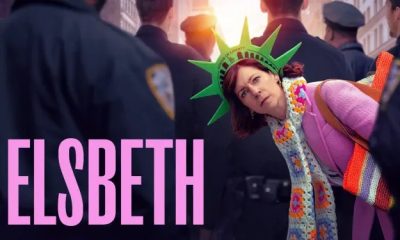
 News1 day ago
News1 day agoElsbeth, May 2, 2024, CBS, “Something Blue”
-

 News3 days ago
News3 days agoJeopardy! Tuesday April 30, 2024, Recap, Winner and Final Answer
-

 News2 days ago
News2 days agoJeopardy! Wednesday May 1, 2024, Recap, Winner and Final Answer
-

 News2 days ago
News2 days agoThe Today Show, May 1, 2024, NBC, “Chris Pine, Billy Idol, Melissa Joan Hart”








